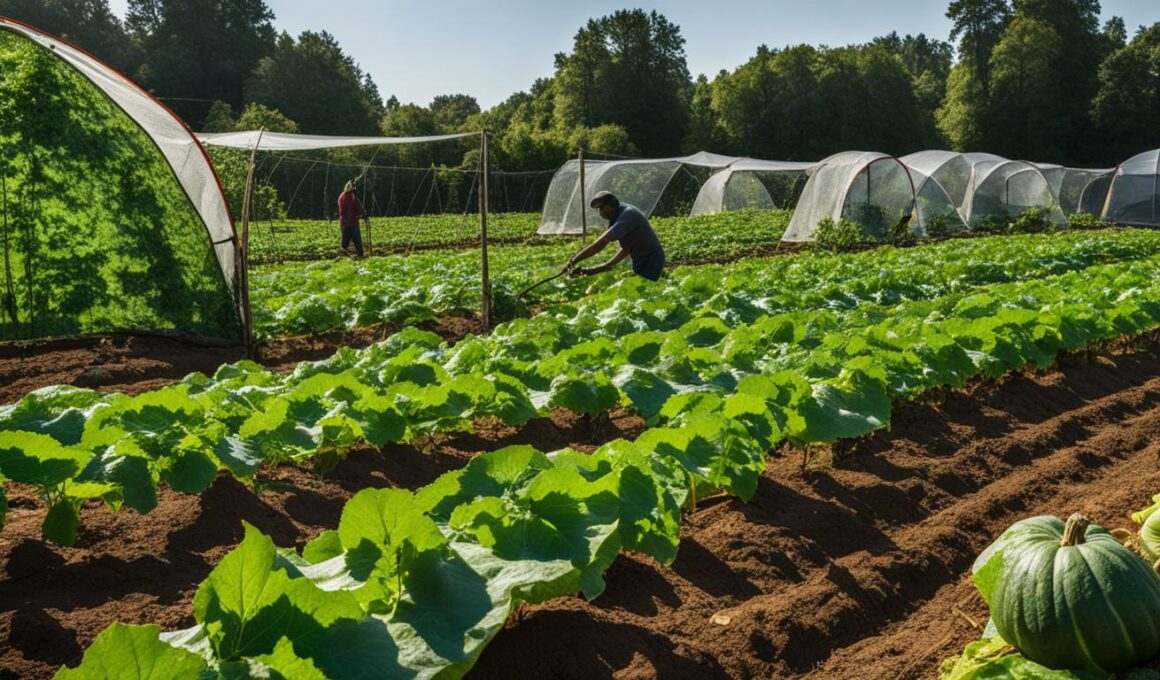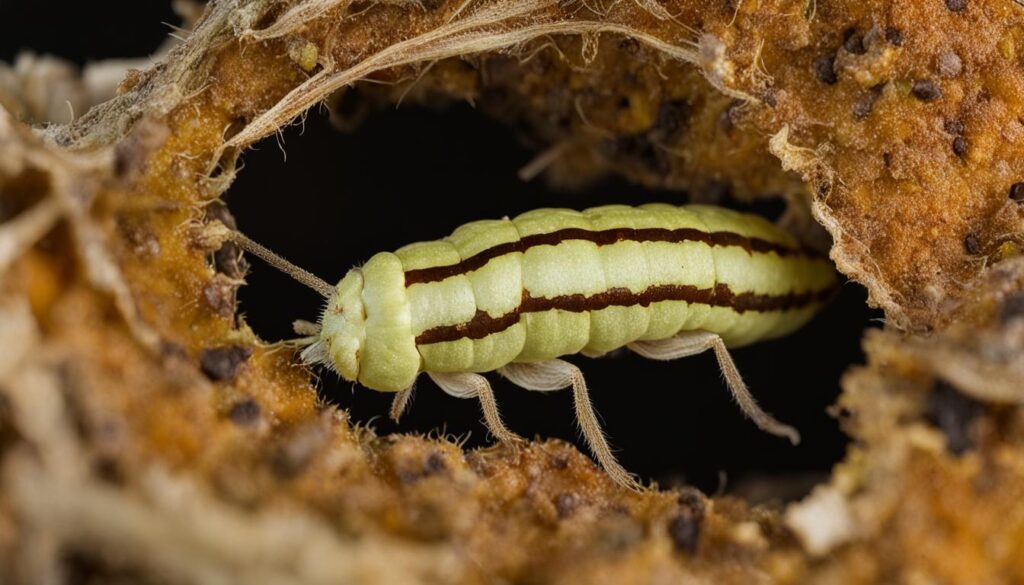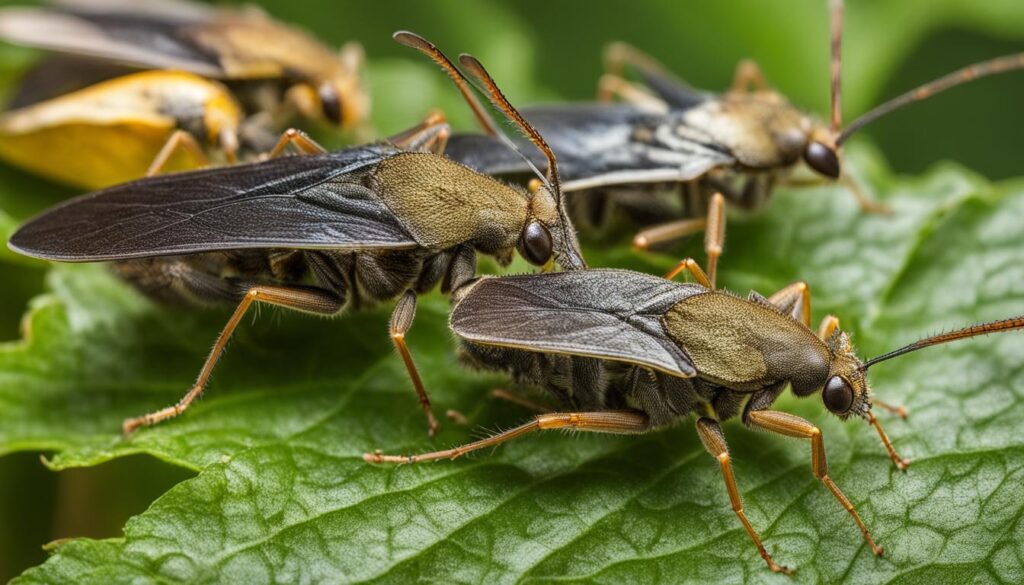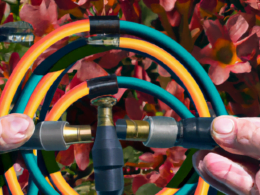Preventing vine borers and controlling squash bugs can be a challenging task for any gardener. These pests can wreak havoc on your squash plants, causing damage and even death. However, with the right techniques and organic pesticides, you can effectively manage these pests and ensure the health of your garden.
Squash bugs lay their eggs on the underside of leaves, while squash vine borers lay their eggs at the base of the plant stems. These pests can quickly multiply and cause significant damage if left unchecked. But don’t worry, we’ve got you covered with some effective strategies to prevent and control them.
Key Takeaways:
- Inspect your squash plants regularly for squash bug eggs and remove them.
- Consider using organic pesticides like spinosad and pyrethrins to control squash bugs.
- Early detection and physical removal of squash vine borer larvae can help minimize damage.
- Implement good garden practices like rotating crops and using barriers to reduce pest populations.
- By following these strategies, you can maintain a healthy garden and prevent pest infestations.
Identifying and Managing Squash Vine Borers
The squash vine borer is a common pest that can wreak havoc on your squash plants. Understanding how to identify and manage these pests is essential for protecting your crops. Let’s explore the key characteristics of squash vine borers and discuss effective control methods.
Identifying Squash Vine Borers
Squash vine borers are moths that lay their eggs on the stems of squash plants. When the eggs hatch, the larvae tunnel into the stems, causing damage to the plant. One of the telltale signs of squash vine borer infestation is the presence of yellowish frass, which is the excrement of the larvae. Additionally, the stems may feel hollow when gently squeezed.
Managing Squash Vine Borers
Physical removal of squash vine borer larvae can be attempted by carefully cutting open the stem and removing the larvae. Burying the damaged portion of the stem can help prevent reinfestation. Another option is to inject the stems with a natural bacterium called bacillus thuringiensis (bT), which targets and kills the larvae. However, it’s important to note that these control methods may not always be successful, especially if the damage to the plant is extensive.
To effectively manage squash vine borers, it is crucial to implement preventive measures. Tilling the soil in the fall and spring helps disrupt the life cycle of the pests. Crop rotation is another beneficial practice, as it helps reduce the population of squash vine borers. Using insecticides at the right time can also provide effective control. Remember, timing is key when it comes to managing squash vine borers.
Tips for Controlling Squash Bugs
When it comes to preventing squash bug infestations in your garden, early detection and control are key. By inspecting your squash plants regularly for squash bug eggs, you can catch these pests before they have a chance to multiply and cause significant damage. Look for clusters of bronze-colored eggs on the underside of leaves, and promptly remove them to prevent hatching. Taking these proactive steps can help you effectively manage squash bug populations and protect your plants.
One effective method for trapping squash bugs is by using boards. Simply place wooden boards near your squash plants in the evening, and check them in the morning. The boards act as hiding spots for the bugs, making it easier to spot and eliminate them. This technique can be especially helpful when combined with regular inspections and egg removal. Remember to dispose of the trapped squash bugs properly to prevent reinfestation.
Organic pesticides can also be useful in controlling squash bugs, particularly when used in the early stages of infestation. Spinosad and pyrethrins are two commonly recommended options for organic pest control. These pesticides can be effective before the bugs mature into adults, preventing them from causing extensive damage to your plants. Always follow the instructions on the product label and be mindful of any environmental concerns when using pesticides.
Summary:
- Inspect your squash plants regularly for squash bug eggs on the undersides of leaves.
- Remove any clusters of eggs to prevent hatching and control squash bug populations.
- Use wooden boards as traps to catch and eliminate squash bugs.
- Consider using organic pesticides like spinosad or pyrethrins for early control of squash bugs.
By implementing these tips for controlling squash bugs, you can protect your squash plants and ensure a healthier garden. Early detection, egg removal, trapping, and the use of organic pesticides are effective strategies for keeping squash bugs at bay. Remember to stay vigilant and take action promptly to prevent these pests from causing extensive damage to your plants.
Additional Strategies for Pest Prevention in the Garden
In addition to controlling squash vine borers and squash bugs, there are several general strategies for preventing pests in the garden. By implementing these strategies, you can create a healthier garden environment and reduce the risk of pest infestations.
1. Garden Cleanup
One of the key steps in pest prevention is good garden cleanup. Regularly removing debris, fallen leaves, and plant residues can help disrupt the lifecycles of pests. It reduces hiding places for insects and diseases, making it harder for them to thrive and reproduce. Additionally, turning over the soil can expose and destroy pests and their eggs, further minimizing their populations.
2. Rotation of Crops
Rotating your crops is another effective strategy for pest prevention. Different pests are often specific to certain plant families, so by changing the location of your crops each year, you can reduce the buildup of pest populations. Rotating crops breaks the cycle of pests finding their preferred host plants and can also help replenish soil nutrients.
3. Use of Barriers
Using barriers is a great way to physically protect your plants from pests. Row covers, for example, can be placed over your plants to create a barrier that keeps pests out while allowing sunlight, water, and air to reach your plants. This prevents insects, birds, and other animals from directly accessing your crops, reducing the chances of infestation.
4. Horticultural Controls
Implementing horticultural practices can contribute to a healthier garden and help prevent pests. Proper watering, weeding, and staking can promote strong and vigorous plants that are more resistant to pests and diseases. Providing your plants with the right growing conditions and care can enhance their natural defenses, making them less vulnerable to attacks.
5. Good Garden Culture
Finally, fostering good garden culture is essential for pest prevention. This includes practicing good sanitation, such as regularly cleaning tools and removing diseased plants. It also involves regularly inspecting your garden for signs of pests and diseases, allowing you to take action promptly. By staying vigilant and proactive, you can effectively manage and prevent pest issues in your garden.
Conclusion
Preventing vine borers and other pests in your garden is essential for maintaining healthy plants and a thriving garden. By implementing a combination of techniques, you can effectively prevent and manage pests, such as squash vine borers and squash bugs.
Early detection is key to controlling these pests. Regularly inspect your squash plants for signs of infestation, such as eggs under the leaves or hollow-feeling stems. Physical removal of the larvae and eggs can be attempted, but it may not always guarantee success.
Organic pest control methods can also be employed to manage vine borers and squash bugs. Spinosad and pyrethrins are effective organic pesticides that can help control these pests. Using these pesticides at the right time, especially before the bugs mature into adults, can significantly reduce their populations.
To ensure the overall health of your garden, it is important to practice good garden care. This includes proper cleanup and regular soil tilling to disrupt pest lifecycles. Rotating your crops and using barriers like row covers can further reduce the risk of infestations. By following these strategies, you can create a pest-resistant garden and enjoy the benefits of a thriving, productive space.
How Can I Use the Information About Vine Borer Beetles to Prevent Infestations in My Garden?
Understanding the vine borer beetle is essential for preventing infestations in your garden. By learning their habits and life cycle, you can take preventative measures such as using row covers, inspecting plants regularly, and promoting healthy soil to deter these destructive pests.
FAQ
How can I control squash vine borers?
Squash vine borers can be controlled through early detection and physical removal of the larvae. Injecting bacillus thuringiensis (bT) into the stem can also help control the larvae, but severe damage to the plant may limit the effectiveness of this method. Tilling the soil in the fall and spring, rotating crops, and using insecticides at the right time can also contribute to managing squash vine borers.
How can I control squash bugs?
Squash bugs can be controlled by inspecting squash plant leaves for clusters of eggs and removing them. Placing boards near the plants can attract squash bugs, making them easier to remove in the morning. Organic pesticides like spinosad and pyrethrins can be used for early control of squash bugs before they mature into adults.
What are some general strategies for preventing pests in the garden?
To prevent pests in the garden, it is important to practice good garden cleanup by removing debris and turning over the soil. Rotating crops and using barriers like row covers can also reduce pest populations. Implementing horticultural controls such as proper watering, weeding, and staking can contribute to a healthier garden environment.
How can I reduce the risk of pest infestations in my garden?
By following good garden practices such as proper cleanup, rotation of crops, and the use of barriers, you can reduce the risk of pest infestations. Additionally, implementing horticultural controls like proper watering, weeding, and staking can contribute to a healthier garden environment.












